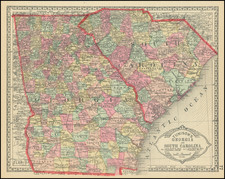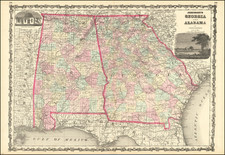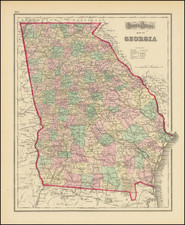One of the Defining Early Views of a Southern American City.
This lithograph is a detailed and beautifully executed view of Savannah, based on a painting by J.W. Hill. The view was lithographed by Charles Parsons and printed by Endicott & Co. in New York in 1855.
The scene captures a panoramic view of Savannah with the Casimir Pulaski Monument prominently in the foreground. This monument honors the Polish nobleman and military commander who played a significant role in the American Revolutionary War and died during the Siege of Savannah.
The city's layout is clearly depicted, showcasing its well-planned streets and public squares, surrounded by lush greenery and numerous trees. The contrast of shadow and light cast by partial cloud cover is expertly and convincingly rendered in this view. In the distance, the Savannah River is visible. The cityscape is filled with detailed renderings of buildings, including many churches with distinctive steeples, residential homes, and public structures.
This is the earliest view of Savannah (or any Georgia city for that matter) in Reps comprehensive Views and Viewmakers of Urban America. However, it is preceded by the 1734 Gordon View of Savannah, which falls outside the remit of Reps's catalog.
Overall, this 1855 lithograph of Savannah is a remarkable piece of visual history, reflecting the architectural, urban, and cultural landscape of the city during a significant period of its development. It was published in New York, USA.
Stokes & Haskell (Addenda, Views-9, pages 148-149) give a detailed treatment of the landmarks to be seen in the view:
The monument in the foreground is the Pulaski Monument on Monterey Square. The original corner stone was laid by Lafayette in Chippewa Square March 21, 1825, and was relaid in Monterey Square October 11, 1853. The street in the center of the view extending from the Monument into the background is Bull Street. The tall dark steeple in the left center is St. John's Protestant Episcopal Church, dedicated March 13, 1853. The low building with cupola partly concealed by the spire of St. John's is the First Baptist Church, completed in 1833. The tall spire beyond, just to the left of Bull Street, is the Independent Presbyterian Church, dedicated May 9, 1819, destroyed by fire April 6, 1889, and replaced by a new building, an exact counterpart of the old, which was dedicated in June, 1891. The small building with low, square tower and cupola on the left side of Bull Street, just beyond it, is the Second Baptist Church, erected originally as a Unitarian church, occupied by the Second Baptist Church during the years 1847 to 1859, and later occupied as an armory by the Savannah Volunteer Guards, and during the winter of 1864-65 by some of Sherman's soldiers as a guardhouse. Through carelessness at this time it caught fire and was completely destroyed. At the far end of Bull Street is seen the Exchange, the corner stone of which was laid June 4, 1799. For many years the lower floor was used as the post office and custom house, while the municipal government occupied the upper stories. It was replaced in 1904 by a new City Hall. In the extreme background is seen the Savannah River. At the extreme right, in the middle ground, is the Old Cemetery, where many of the noted inhabitants of earlier days were buried. It was closed to further interments July 1, 1853, and was later taken over by the city government, and is now known as Colonial Park.
Rarity
Reps notes examples at the New York Public Library, Georgia Historical Society, University of Georgia, Mariner's Museum Newport News, and New-York Historical Society.
Several examples have been through the market in the early 2020s.









![[Untitled Coast chart of North Carolina, South Carolina, Georgia, and Florida, with insets of the harbor of Charleston, S.C. and the entrance of the Saint Johns River]](https://storage.googleapis.com/raremaps/img/small/91737.jpg)


![The City of Savannah Georgia [with] The City of Charleston South Carolina](https://storage.googleapis.com/raremaps/img/small/71779.jpg)

![[ Carolinas, Georgia, etc ] Virginiae Partis australis, et Floridae partis orientalis, interjacentiumqus regionum Nova Descriptio](https://storage.googleapis.com/raremaps/img/small/89657.jpg)